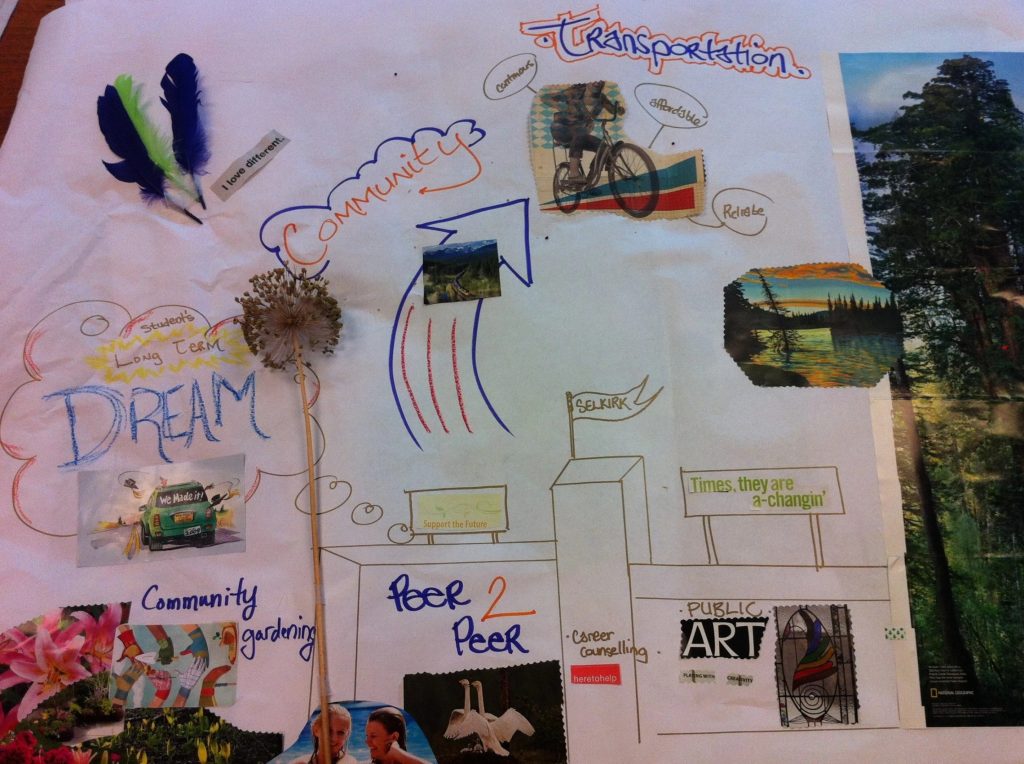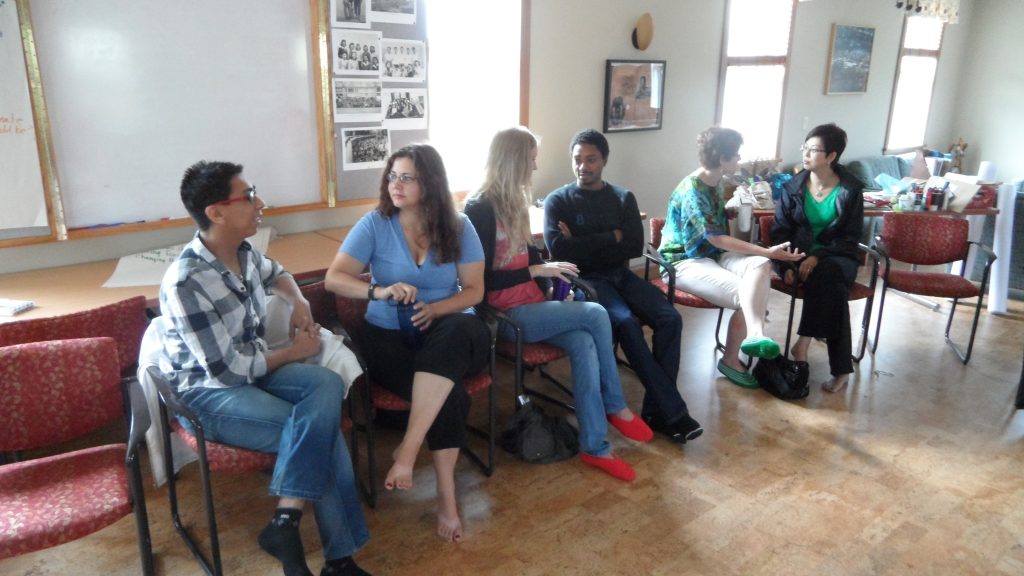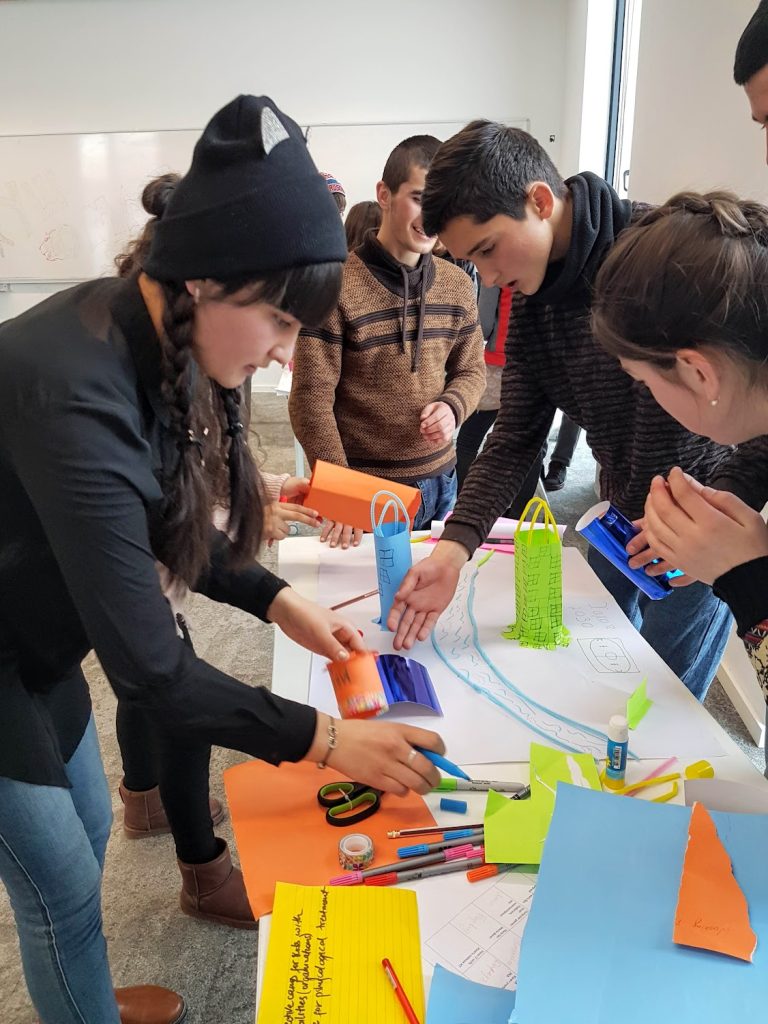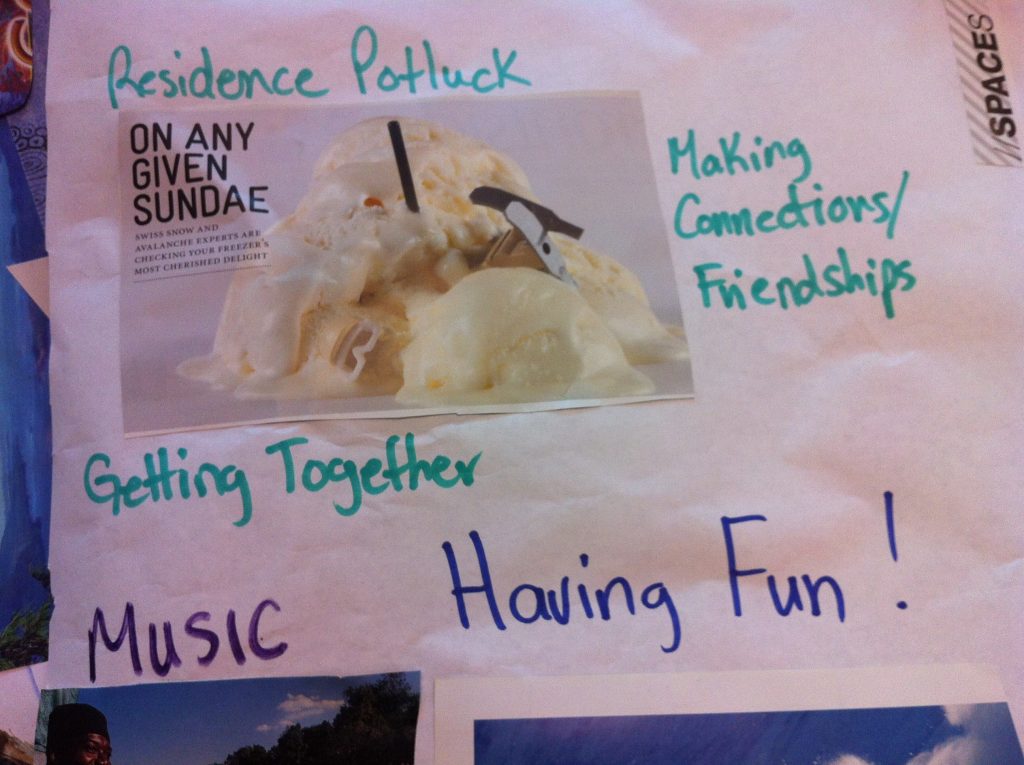“We want to nuture a great Selkirk College VIBE that everyone can feel and wants to be a part of. We want an overall sense of belonging that is being co-created by everyone’s energy and intentions.”
37 Dreaming the Future: Murals of Possibility
– Selkirk student statement during debriefing of a dream mural activity

The Dream Mural process was adapted from an Appreciative Inquiry process used at the Dalai Lama Centre for Peace in Vancouver as part of their Heart-Mind Education program. We used their visioning exercise to explore what a campus in Canada and a small town in Tajikistan might look like in the future if students and youth were engaged, healthy and thriving.
Purpose
The purpose of dream murals is for a group or organization to collaborate on shared visions of the future and to develop plans towards implementation.
APPRECIATIVE INQUIRY INTERVIEW QUESTIONS
Appreciative questions evoke images of the ideal future and invite reflection on how to get there. A typical appreciative interview guide consists of three standard questions that explore: best experience (past), values (present), and wishes (future).
The Dream Mural activity used in these two case studies does not purport to be appreciative inquiry in its purest form as we were not trained Appreciative Inquiry facililtators and we had time contraints in the workshops where it was used. However, we engaged with the spirit of appreciative inquiry that aspires to build on strengths and the forward thinking visions of both individuals and organizations:
Appreciative Inquiry is an energizing and inclusive process that fosters creativity through the art of positive inquiry. It builds new skills in individuals and groups, develops new leaders, encourages a culture of inquiry, and helps create shared vision and purpose by building on an organization’s core values and strengths. It invites individuals to engage in building a future they want to live in.
Learn more about Appreciative Inquiry here:
Learning Objectives
Participants will:
- Join a community of practice that includes diverse stakeholders exploring community wellbeing.
- Imagine future possibilities where people are thriving.
- Plan an action that can start bringing one of the dream themes into reality.

Activity Directions
- Pairs: Ask participants to find a partner and share with them a positive experience they have had in this community.
“Tell me a story about a best experience you have had with your ______ (i.e., family, team, community, network, or another group). What made this experience a highlight for you? Please describe this experience in detail.”
2. Switch roles: After 10 minutes switch roles so that the speaker becomes the listener.
3. Full Group Discussion: After 20 minutes, when both partners have shared their positive experiences, bring the big group back together to explore the values that lay beneath the stories.
What things do you value about yourself, your work, your family, and your organization? What do you value most about the story you shared? What values did you hear from your partner?
Record values on board or flip chart.
4. Dream Phase: Ask participants to make themselves as comfortable as possible. If the environment permits, people could be lying on yoga mats inside or outside as they close their eyes and listen to the following guided visualization.
Dreaming the Future Time Travel Visualization Script
Take a few moments to fully relax . . . . . . . Breathe in through your nose and then release a long out breath in a sigh through your mouth. Please do three more full breaths in your own time, noticing the breath coming into your body and then releasing out into the atmosphere.
Relax body, relax. Relax, mind relax. Allow yourself to sink into a place where you are fully relaxed and can recieve messages and images that will help us with our visioning task.
I would like you to imagine that your have travelled into the future. You are now living in our community as it could be in five years in the year 20 _____. You start exploring this place that you know so well and you realize many positive changes have taken place. People you see appear healthy and relaxed. The environment is welcoming. It is a place where community members like being there. They are comfortable, engaged and thriving.
For the next 5 minutes I would like you to just keep looking around this place of the future. What tells you that positive changes have happened? What specific physical changes or programs or supports have helped create this healthy environment? How do you feel as you wander through this improved space? What other things have helped create this future where there is a palpable sense of belonging and wellbeing?
Now we are going to come back to our present time and place. Slowly wiggle your toes and fingers. Open your eyes. Take the pen and paper lying beside you and for the next 5 minutes write about your experience of wellbeing and ideas that you envisioned during your time travel visualization.
5. Small group collaboration: Create small groups of 3-5 people. Ask them to share their visions of the future, identify themes and create a dream mural about what the future would look like if your community was a healthier, happier place to be.
6. Ten Minute Alert: Give groups a 10-minute warning that they will be coming back to the larger gathering. Ask them to look at their dream mural and identify salient themes and decide how they want to present their mural to the larger group.
7. Presentations: Give each group 3 minutes to present their most important themes. After all groups have presented, the facilitator can summarize what they have heard and reflect on some of the themes that emerged.
8. Identify one theme that the group wants to work on: Ask the group to identify one theme that they would like to start working on towards that future vision. What would be the first steps? What are the power dynamics and social structures that need to be addressed and included in these conversations for change to happen?
9. Action Plan: Come up with an action plan for starting one initiative that will move the institution towards this desired future. (It could be that this planning phase happens at another meeting, but it is optimal if you can end the dream process with some concrete actions that will move the group towards their vision.)
9. Collect data, summarize and share: The facilitator should collect the dream murals and collate the ideas that emerged. These summarized visions and action items can be sent back to the participants and also presented to those layers of the institution with decision making power, so that the collective vision continues to propel forward movement. Dream murals are the beginning step of a change making process.

Case Study #1: Selkirk College Mental Health Council Planning Day
Selkirk students, staff and community members formed a Community of Practice to explore campus culture and substance use. This was part of larger health promotion project initiated by Healthy Minds|Healthy Campus and the Canadian Institute for Substance Use Research at the University of Victoria. During the planning meeting, we facilitated a dream mural process that helped design initiatives that the group wanted to implement on campus.
Themes that emerged from the dream mural process:
- Wanting a welcoming, inclusive environment
- For everyone – staff and students – there are NO BYSTANDERS- – if there is a situation that is not contributing to a healthy community EVERYONE feels that they can step in to help, or speak out, or stand up for their values and everyone feels safe.
- Needing a place to get together and socialize – A place that serves local foods, coffee, wine, beer with a Coffee House atmosphere – music, poetry, discussions, art
- A social hub for information exchange, supports to students,
- Hub provides some student employment and job and career information.
- This hub might have green houses attached – community gardens, farmers markets
- There might be some alcohol, but it is embedded in a healthy, vibrant context and not misused.
- All staff and student leaders have training to respond to people who they notice being sad, withdrawn, isolated, psychotic or intoxicated
- Multi-generational events – are there times or places on campus that we can include children or grandparents? Or animals? Pets for the Pit? Sometimes the post secondary culture is disconnected from a greater sense of normal families and cultures and society. Could we do more with the campus Day Care Center?
From this half-day workshop, people committed to a new date to meet and create an action plan. Training for staff and student leaders around Mental Health First Aid training skills was identified as a do-able first step.
Results from this visioning process were shared with management and it was a contributing factor towards creating a paid position for a Healthy Campus Advisor who would work with staff and students on wellbeing initiatives.
To read more about the process and themes from this “Dreaming the Future” activity please read this blog post: tenthstreetdinner.wordpress.com/healthycampus
Case Study #2 Khorog Youth Engagement Program
Elders within the council at the Ismaili Centre in Khorog, Tajikistan, approached Student Services at the University of Central Asia about concerns they had with some of the mental health and wellbeing of their highschool youth. They asked for ideas on how best to engage youth in positive ways. We decided we wanted to listen to the voices, concerns and dreams of the Khorog teens. We used photo voice and dream murals to tap into their visions for themselves and the future of their community.
When youth talked about their positive experiences and what they loved about Khorog, they included:
- Beautiful nature – rivers and mountains
- They love the Central Park.
- They are proud of the new Ismaili Centre, university and hospital.
- Like Pamiri music and dancing
- Like family celebrations.
- Like hanging out with their friends and listening to music from Russia, America and Iran.
- Like sports and attending competitions.
In the Dreaming the Future exercise, we asked them to travel to the future and envision Khorog in 2030. If it was thriving and youth were engaged and happy to be there, what would the town look like and feel like?
Themes for a Healthy Khorog 2030
- More jobs for youth so they don’t need to leave to Dushanbe or Russia to find employment
- More training programs for different kinds of jobs.
- More acceptance from parents that trades and practical careers are valuable too (not everyone wants to go to university).
- Families are still close and supportive and helping each other.
- More sport facilities like a swimming pool and gyms.
- Less garbage and better ways for disposing of garbage.
- Warmer schools where jackets don’t need to be worn through winter.
- Facilities upgraded including more and better toilets.
- Less punishment and shaming in schools.
- Better communication between generations.
- Meeting places where teens can hang out – especially in winter.
- Places where youth can do art and music.
- School courses that are more relevant and related to every day life.
- Better transportation to Dushanbe – airport running again and road improved.
- Better transportation within Khorog on the weekends so that teens can get together.

Dream mural includes buildings along the river where teens can go to meet and engage in art and music.

The Khorog Youth Engagement Project included 35 Khorog highschool students, but we also had 6 university student mentors who worked with the teens to develop their visions and stories. I interviewed all of the mentors about what they had learned from the teens and then posted their insights in Russian and English for the students, teachers and parents to read.
Insights from Mentors:
- “I have learned that the teens are quite worried about the problems in Badakhshan. They are not neutral. They care about the future of their community. Many talked about unemployment and wanting to go other places where there are jobs. When we did the mapping exercise it was clear they want more choices for their future.”
- “What I observed was that the teens don’t just think about themselves, but they also think about how they can contribute to the whole community. Students want good jobs in Khorog because they want to help the town improve. The highschool students want self-development, but they also want the children and elderly and all people of GBAO to have better quality of life.”
- “When I talked to these highschool students I could tell that they wanted something new and more fun for young people in Khorog. Mostly they wanted new buildings that made Khorog more modern and exciting, but they also had new ideas that I hadn’t thought of. For instance these didn’t like the fact that there is no transportation on the weekends. That frustrated them. My students worked really well together and listened to each other.”
Materials and Resources Needed
- big sheets of paper – preferably rolls of butcher paper or flip charts taped together to make bigger pieces
- smaller pieces of coloured paper and collage materials
- markers
- magazines
- scissors
- glue
- tape

